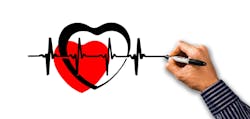Researchers at San Diego School of Medicine found that a drug used for heart failure improves symptoms associated with postural orthostatic tachycardia syndrome, otherwise known as POTS. This complex, debilitating disorder affects the body’s autonomic nervous system, causing a high heart rate, usually when standing, according to a news release from the university.
Recently, POTS has been identified as a potential “long-hauler” symptom of COVID-19.
Writing online in the Journal of the American College of Cardiology, study authors investigated the drug ivabradine and its effects on heart rate, quality of life and plasma norepinephrine levels in persons living with POTS.
POTS is typically caused by a viral infection, trauma, surgery or enforced bedrest, and most commonly affects young women who are either athletes or highly active. Currently, there is no treatment for POTS approved by the U.S. Food and Drug Administration (FDA). Other symptoms of POTS include “brain fog,” lightheadedness, palpitations, tremors, weakness, blurry vision and fatigue.
Norepinephrine is a stress hormone and neurotransmitter. In blood plasma, it is used as a measure of sympathetic nervous system activity. Trial participants experienced a reduction in heart rate, improvement in their symptoms and overall quality of life one month after taking the drug.
“Ivabradine is a novel agent that’s FDA-approved for heart failure but based on its mechanism, we thought it could be helpful for patients with POTS as it reduces heart rate without impacting blood pressure,” said Pam Taub, MD, cardiologist at the Cardiovascular Institute at UC San Diego Health and Associate Professor of Medicine at UC San Diego School of Medicine.
The study involved 22 individuals whose average age was 32 years. Each participant had been screened and recruited from cardiology clinics at UC San Diego Health from 2018 to 2020.
The study utilized a randomized, double-blinded, placebo-controlled crossover design in which patients started on either ivabradine or a placebo for one month. At the end of the month, all participants underwent a washout period where neither drug nor placebo was taken for one week. After the washout period, the participants who had previously received ivabradine switched to placebo and vice versa for one month.
Over the course of the two months, patients also met with researchers for seven different clinic visits in which plasma norepinephrine levels were measured and head-up tilt testing conducted to observe the patient’s heart rate when sitting, lying down or standing up.
Taub said the study was the first randomized clinical trial using ivabradine to treat POTS.

